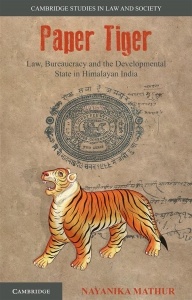Once upon a time a Brahman walking along a road came across a tiger shut in an iron cage.* ‘Brother Brahman, brother Brahman,’ shouted the Tiger as soon as he spotted the man. ‘I am dying of thirst. Have pity on me, and let me out of this cage to drink some water. I will not eat you. I will never be so ungrateful.’ The Brahman took pity on him and opened the cage door. The Tiger quickly jumped out and said, ‘Now first I will eat you, and then I will drink some water.’ ‘Do not kill me hastily. Let us ask the first three things we meet for their opinion. If all of them agree that you should eat me, I will die,’ replied the Brahman.
Paper Tiger: Law, Bureaucracy and the Developmental State in Himalayan India – unconsciously echoing the well-known Indian folk tale ‘The Brahman, the Tiger and the Six Judges’ – brilliantly tells of how a tiger (the Indian state and society), a Brahman (local laws on development) and the government attempt to alter the life chances of underprivileged citizens. The book lies within the recently established interpretative traditions of William Gould, Matthew Hull and Anastasia Piliavsky in exploring corruption, the materiality of bureaucracy and patronage in South Asia. Its methodology combines the perfect blend of historical, literary and anthropological techniques by drawing on the most recent literature on the anthropology of space, place, time and the everyday state, official documents, vernacular newspapers and participant observation of the office life of a government department.
The setting of this outstanding book is Gopeshwar, a town in the Himalayan borderlands. Gopeshwar’s remoteness mirrors the physical distancing of the institutional nerve centres from many locals’ everyday experience of the state. Likewise, the story of the sole petrol pump in town echoes that of the frontier towns and the hinterland outposts. The small station is a further imaginary line that locally signposts the institutional gap and ‘breakdown in communications’ between the state and its citizens. It is precisely this marginalisation and underdevelopment that make Gopeshwar (and the wider district of Chamoli) a perfect case study of how laws on development ‘are translated into practice […] words are interpreted, understood and acted upon lower-level bureaucrats’ (2), and of why, in some cases, they ‘do not work as they ought [… and] are capable of producing absurdity’ (2). Will our Brahman get the better of our tiger, then? And how?
The Brahman and the tiger walked on till they found a Bullock. ‘Brother Bullock, brother Bullock’– said the Brahman – ‘the Tiger begged me to let him out of the cage, promising to not eat me. But now that I have set him free, he wants to eat me. Is it just that it should do so?’ ‘When I was able to work, my master fed me’ – the Bullock got back to him – ‘Now that I am old he has forgotten me and left me by the roadside to die. Let the tiger eat you. Men have no pity.’
Image Credit: (kafka4prez CC BY SA 2.0)
In India as elsewhere in South Asia, development is a constituent part of the institutional life of the state. Its very essence is therefore marked by contingency, precariousness, coercion and affect. Nayanika Mathur first navigates the uncharted waters of the dichotomy between the state and the ‘real’ life of all laws and their related implementation. ‘This is what the [state and the law] says,’ warns a sarcastic District Development Officer, after reading an advertisement placed in a local newspaper. ‘God alone knows what the real situation is’ (62). Paper Tigerauthoritatively engages with those grey areas wherein the ‘real’ situation challenges the apparently flawless rationale of the law and official narratives and, more broadly, the traditional socio-anthropological literature on bureaucracy, development and state failure.
Throughout Mathur’s ethnography, the multi-faceted nature of Indian society and its (at times institutionally sanctioned) tendency to resort to ‘informal’ stratagems constantly flout the convention of the procedural observance of operational guidelines. The massive production of papery artefacts – the local cure-all solution to the endemic need for more transparency and accountability – further short-circuits the bureaucratic implementation of laws. Paradoxically, it is the state life of development laws that carves out temporal room for unimplementability and absurdity. After all, as the words of one local unnamed citizen highlight to Mathur by somehow evoking the story of the Bullock: ‘all this development work is only for the [state]. The Board[s] [and the documents that pile up on officers’ desks] [… are] not for us poor. This is the real thing’ (168-69).
After a little while they met a camel. ‘Sir Camel, Sir Camel’ – said the Brahman –‘hear and give judgement’. ‘When I was young and strong, my master took care of me.’ – the Camel replied – ‘Now that I am old and have lost all my strength in his service, he beats me without mercy. Let the Tiger eat the man, for men are unjust and cruel.’
Translating development laws into practice even impacts on the relational set of practices through which the state substantiates itself at the grassroots. Paper Tiger contributes new important models for exploring epistolary and meeting practices as crucial performative expressions of the state body and its inner, regular workings. As they move back and forth across the imaginary lines of government departments and hierarchies, letters of clarification, notices and orders – in other words, all the paperwork connected to the implementation of law – become an essential tool in managing relationships, individual clout, power and patronage networks. Lower-level officers who carefully choose words and addressees herein counterbalance the archetypal image of the Indian state as an invertebrate writer. Indeed, their writing routines and ‘neuroses’ allow the Indian state to come into being. Reading, writing and forwarding letters is thus far from a ‘process-generated dull parchment’ (31). It is both an art to be learned gradually and a central ‘process whereby laws can be interpreted […] and the paper state assembled’ (31).
Similarly, Mathur vividly recreates the anxious atmosphere that regularly envelops scheduled meetings. In her thorough analysis, conferences and audits become the stage for the peripheral branches of the state to gather together. Attendees stage a curious comedy of manners in which all the different members of the state bureaucracy describe themselves as, and feel part of, the same entity. Whether on paper or in office life, bureaucrats have all to perform. They cannot lose – not even for a second – their ‘strength in service’. Otherwise, as a senior state official reminds us, ‘do you know how poorly it reflects on us if we are unable to get work out of them’ (126)? What happens, then, if an actual tiger suddenly appears in town? Will the law live up to its potential? How will officers react?
The Brahman told his story even to the Jackal. ‘Mama Jackal, Mama Jackal, say what is your judgement’. ‘It is impossible for me to decide’, answered the Jackal. ‘How were you within the cage’ – asked the Jackal to the Tiger – ‘which way were you looking?’ ‘I stood so’, said the Tiger, jumping into the cage. ‘Was the cage open or shut?’ went on the Jackal. ‘Shut and bolted’, promptly replied the Brahman. ‘Then go and bolt it’, ordered the Jackal.
In the winter of 2006-07, horror and fear grip Gopeshwar. A tiger sneaks around the roads of the small town of the Himalayan district. The man-eating big cat has just established its reign of terror. In these months, the clash between the paper state and real life fully and repeatedly surface. Local officers’ frenzied enactment of routine (papery) procedures appears to add to the confusion. In turn, citizens panic and angrily contest or malign state authorities. In fact, the successful mediation of these conflicting social times results from lower bureaucrats’ cunning exploitation of their in-depth knowledge of the loopholes that tend to make all development laws unimplementable and at times absurd. In late January 2007, a local hunter brings the tiger’s reign of terror to an end. The forces of evil have been defeated and local bureaucrats can now go back to their (paper)work. To a certain extent, the law itself has somehow triumphed over Gopeshwar’s messy ‘real life’.
Paper Tiger is a brilliant book, an outstanding achievement of research and understanding. Mathur’s witty and accessible prose rests on a foundation of serious scholarship and groundbreaking methodology. Still, the glancing references to ordinary citizens’ perceptions of the state leave a nasty taste in the readers’ mouth. One would expect (or, perhaps, would be curious) to know in detail how beneficiaries themselves survive the paper state, its mechanisms and its ironic absurdities. Nevertheless, Paper Tiger is highly recommended, essential reading for all those first approaching the study of the Indian subcontinent, NGO workers and institutional and private international development donors.
When the Brahman shut the Tiger in his cage, the Jackal said: ‘Oh, you, ungrateful Tiger, stay there for the rest of your life. I hope that no one will ever let you out again. Proceed on your journey, my dear Brahman. You are now safe’.


No comments:
Post a Comment